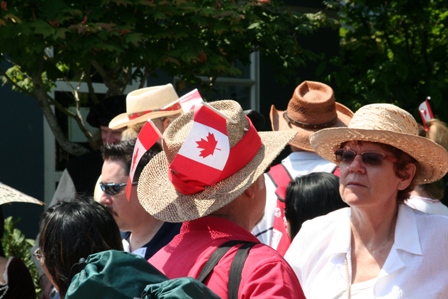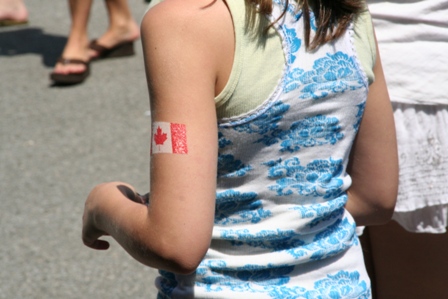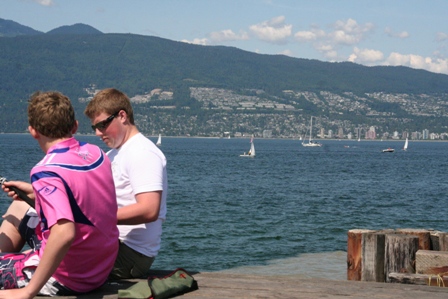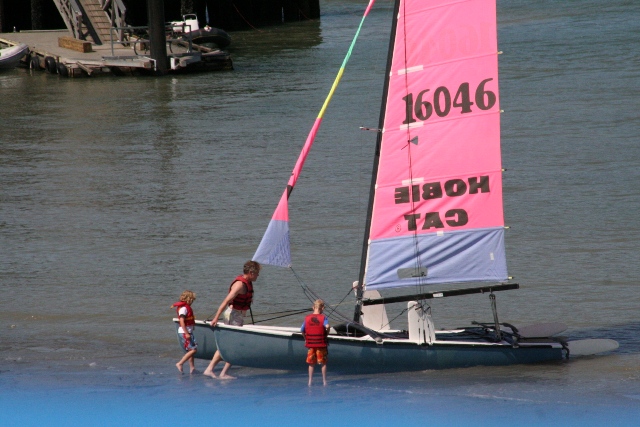|
|
|
|
|
Things to know about Canada |
|
|
|
 |
|
|
|
Political System
Canada is a constitutional monarchy and a federal state with a democratic system of government. The Parliament of Canada, in Ottawa, consists of the House of Commons, whose members are elected, and the Senate, whose members are appointed. On average, Members of Parliament are elected every four years.
Charter of Rights and Freedoms
Canada's Constitution contains a Charter of Rights and Freedoms, which sets out certain fundamental freedoms and rights that neither Parliament nor any provincial legislature acting alone can change. These include equality rights, mobility rights and legal rights, together with freedoms such as speech, association and peaceful assembly.
National Emblem
The maple leaf has been associated with Canada for some time: in 1868, it figured in coats of arms granted to Ontario and Quebec, and in both World Wars, it appeared on regimental badges. Since the 1965 introduction of the Canadian flag, the maple leaf has become the country's most important national symbol.
The Canadian Flag
Several people participated in designing the Canadian flag. Jacques St. Cyr contributed the stylized maple leaf, George Bist the proportions, and Dr. Gunter Wyszechi the colouration. The final determination of all aspects of the new flag was made by a 15-member parliamentary committee, which is formally credited with the design. After lengthy debate, the new flag was adopted by Parliament. It officially became the national flag on February 15, 1965, now recognized as Canada's Flag Day.

National Anthem
"O Canada" was composed in 1880, with music by Calixa Lavallée and words by Judge Adolphe-Basile Routhier. In 1908, Robert Stanley Weir wrote the translation on which the present English lyrics are based. On July 1st, 1980, a century after being sung for the first time, O Canada was proclaimed the national anthem.
Most people's conception of Canada goes little beyond appreciating its vastness, recognizing its flag and identifying a few well-known physical features. And while it's true that the majority of travelers are attracted by the opportunity to explore Canada's wilderness areas, natural wonders and low-key rural charm, there is a lot more to Canada than maple trees, Niagara Falls and wide open spaces.
It's the edginess between Canada's indigenous, French and British traditions that gives the nation its complex three-dimensional character. Add to this a constant infusion of US culture and a plethora of traditions brought from Europe, Asia and Latin America by migrants, and you have a thriving multicultural society very much in the process of forming its own identity. Those expecting Canada to be a blander counterpart of the USA should check their preconceptions at the door - Canada's wild northern frontier, which has etched itself into the national psyche, and its distinct patchwork of peoples have created a country that is decidedly different from its southern neighbor.

Full country name: Canada
Area: 9,976,000 sq km (3.9 million sq mi)
Population: 31,280,000
Capital city: Ottawa (pop: 1,010,500)
People: British descent (28%), French descent (23%), Italian descent (3%), aboriginal peoples (2%), plus significant minorities of German, Ukrainian, Dutch, Greek, Polish and Chinese descent
Languages: English, French and 53 native languages
Religion: Catholic (45%), Protestant (36%) and minorities from most of the world's major religions
Government: Parliamentary democracy
Prime Minister: Jean Chrétien
Governor-General: Adrienne Clarkson
GDP: US$774 billion
GDP per head: US$25,000
Annual growth: 3%
Inflation: 3%
Major products/industries: processed and unprocessed minerals, food products, wood and paper products, transportation equipment, chemicals, fish products, petroleum and natural gas
Major trading partners: USA, Japan, EU (UK, Germany, Netherlands), China and South Korea
Facts for the Travellers
Visas: Most western visitors don't need a visa to visit Canada. Travellers from South Africa, China, North Korea, Taiwan, Eastern European and developing countries do require them. Entry stamps for visits of up to six months are free.
Health risks: Giardia, Rabies and Lyme Disease (in wooded regions)
Time: There are six time zones ranging from Newfoundland Standard Time in the East (GMT/UTC -3.5) to Pacific Standard Time in the West (GMT/UTC -8). During Daylight Saving Time (Apr-Oct), the range is -2.5 to -7

Electricity: 110/120V 60Hz
Weights & measures: Metric
Tourism: 50 million visitors (approx) per year, 90% of whom are US citizens
When to Go
Spring, summer and autumn are all ideal for touring, though if you want to ski you'll naturally have to come in winter or early spring. For campers and those who want to visit the far north, the summer months of July and August are best. Summer is also when many of the country's festivals take place. Note that the peak tourist season is between mid-June and mid-September. Although spring and autumn have fewer crowds, lower prices and a more relaxed pace than the summer months, some visitor-oriented facilities and attractions may be closed during these shoulder seasons.
Events
The Quebec City Winter Carnival, which takes place during the last two weeks of February, features parades, ice sculptures, a snow slide, dances and music. Ottawa's three-week Winterlude fetes all things snowy in February. The Montreal Jazz Festival at the end of June and the Ottawa International Jazz Festival in July both attract international and local players. Two major events in Toronto held in June are Caribana, a cultural exchange offering ethnic music, dance and food, and the Gay Pride Day Parade through the downtown area. In September, there's the Toronto International Film Festival. Calgary hosts the popular Calgary Stampede in July, the highlight of which is the chuck wagon race and rodeo. In the west, Victoria celebrates the First Peoples' Festival in August with traditional craftwork, dancing and war-canoe rides.
Public holidays
January 1 - New Year's Day
3rd Monday in February - Family Day (Alberta)
Monday nearest March 17 - St Patrick's Day (Newfoundland)
March/April - Good Friday & Easter Monday
Monday nearest April 23 - St George's Day (Newfoundland)
Monday before May 24 - Victoria Day (except in the Atlantic Provinces)
June 24 - Fête Nationale (Québec)
Monday nearest June 24 - Discovery Day (Newfoundland)
Monday nearest July 13 - Orangeman's Day (Newfoundland)
1st Monday in August - Civic Holiday
3rd Monday in August - Discovery Day (Yukon)
1st Monday in September - Labor Day
2nd Monday in October - Thanksgiving
November 11 - Remembrance Day
December 25 - Christmas Day
December 26 - Boxing Day
Money & Costs
Currency: Canadian dollar
Meals
Budget: CAD5-15
Mid-range: CAD15-30
Top-end: CAD30 and upwards
Lodging
Budget: CAD15-30
Mid-range: CAD30-80
Top-end: CAD80 and upwards
Widely different income levels in Canada mean you can find accommodation, food and entertainment to suit any budget. In general the three northern territories are the costliest, followed by Ontario, Alberta and British Columbia. Manitoba, Saskatchewan, Québec and Atlantic Canada will put the least pressure on your wallet. For most visitors, the largest expense will be accommodation. Food prices are generally much lower than those in Western Europe, but are higher than those in the USA. If you stay in budget accommodation and eat in cafes, expect to spend around CAD70 a day, not including long-distance transport. If you stay in motels and eat at restaurants occasionally, you're looking at around CAD90 a day.
It's best to change money at companies such as Thomas Cook, which specializes in international transactions. If you can't find a money exchange office or booth, try a bank. American Express and Thomas Cook are the best travelers' checks to have, and you should make sure they are either in US or Canadian dollar denominations. Credit cards are widely accepted, especially Visa, MasterCard and American Express. ABMs (ATMs) are common throughout Canada, with the Interac system the quickest and most convenient way to replenish cash.
A 7% Goods & Services Tax (GST) is applicable to all transport, accommodation, restaurant meals and just about anything else you're likely to purchase, including newspapers. On top of this, in most of Canada, a provincial sales tax also must be paid. This can, in some provinces, add 15% to the quoted price, so factor it into your expenses so you don't get a nasty surprise at the cash register.
It's considered normal to tip 10-15% of the bill. Tips are usually given to waiters, cab drivers, hairdressers, hotel attendants and, by savvy drinkers, bar staff.
Economy—overview
As an affluent, high-tech industrial society, Canada today closely resembles the US in its market-oriented economic system, pattern of production, and high living standards. Since World War II, the impressive growth of the manufacturing, mining, and service sectors has transformed the nation from a largely rural economy into one primarily industrial and urban. Canada started the 1990s in recession, and real rates of growth have averaged only 1.1% so far this decade. Because of slower growth, Canada still faces high unemployment—especially in Quebec and the Maritime Provinces—and a large public sector debt. With its great natural resources, skilled labor force, and modern capital plant, however, Canada will enjoy better economic prospects in the future. The continuing constitutional impasse between English- and French-speaking areas is raising the possibility of a split in the federation, making foreign investors somewhat edgy.

GDP: purchasing power parity—$658 billion (1997 est.)
GDP—real growth rate: 3.5% (1997 est.)
GDP—per capita: purchasing power parity—$21,700 (1997 est.)
GDP—composition by sector
agriculture: 3%
industry: 31%
services: 66% (1997)
Inflation rate—consumer price index: 1.8% (1997)
Labor force
total: 15.3 million (1997)
by occupation: services 75%, manufacturing 16%, agriculture 3%, construction 5%, other 1% (1997)
Unemployment rate: 8.6% (December 1997)
Budget
revenues: $106.5 billion
expenditures: $117.2 billion, including capital expenditures of $1.7 billion (1996)
Industries: processed and unprocessed minerals, food products, wood and paper products, transportation equipment, chemicals, fish products, petroleum and natural gas
Industrial production growth rate: 1.7% (1997 est.)
Electricity—capacity: 113.645 million kW (1995)
Electricity—production: 532.64 billion kWh (1995)
Electricity—consumption per capita: 17,448 kWh (1995)
Agriculture—products: wheat, barley, oilseed, tobacco, fruits, vegetables; dairy products; forest products; commercial fisheries provide annual catch of 1.5 million metric tons, of which 75% is exported
Exports
total value: $208.6 billion (f.o.b., 1997)
commodities: newsprint, wood pulp, timber, crude petroleum, machinery, natural gas, aluminum, motor vehicles and parts; telecommunications equipment
partners: US, Japan, UK, Germany, South Korea, Netherlands, China
Imports
total value: $194.4 billion (c.i.f., 1997)
commodities: crude oil, chemicals, motor vehicles and parts, durable consumer goods, computers; telecommunications equipment and parts
partners: US, Japan, UK, Germany, France, Mexico, Taiwan, South Korea
Debt—external: $253 billion (1996)
Economic aid
donor: ODA, $1.6 billion (1995)
note: ODA and OOF commitments, $10.1 billion (1986-91)
Currency: 1 Canadian dollar (Can$) = 100 cents
|
|
|
|

